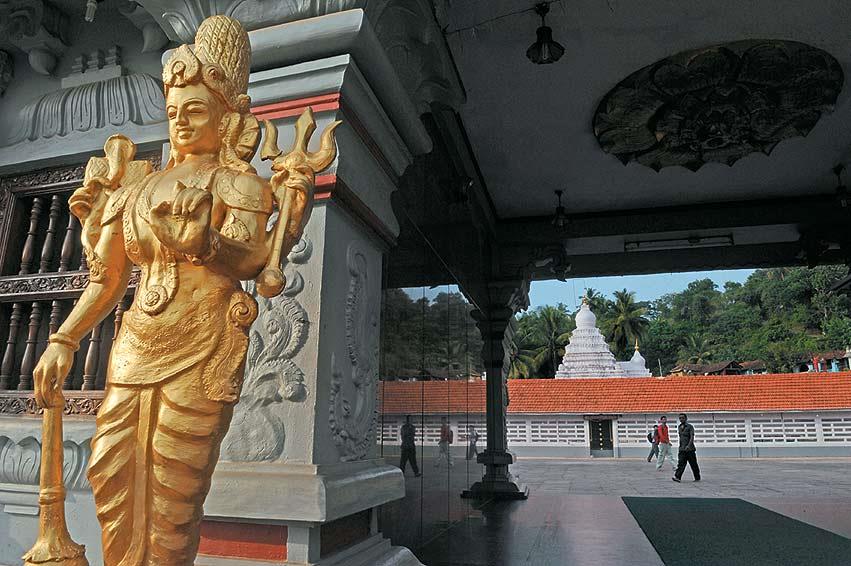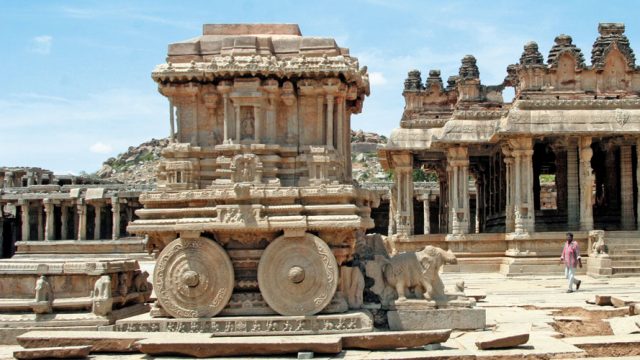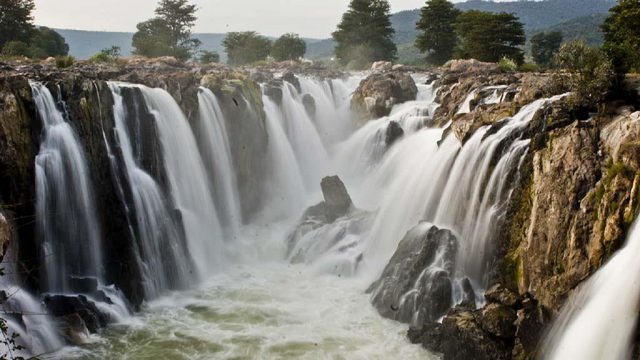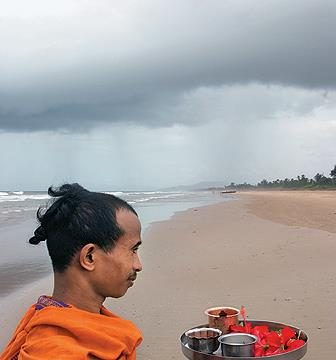Apart from the wonderful Udupi food and the marvellous array of seafood that the western coast of
This is a vertical sundae, a concoction invented in Mangalore. In a tall glass, they lay a bed of fruit salad, pile up three scoops of ice cream in any flavours you fancy, sprinkle it with dry fruits and tutti-frutti and, to finish up, pour some honey and vividly coloured syrup all around.
A bit of everything. It occurred as I was eating it that it wasn’t a half-bad description of my own jaunt up the coast of Karnataka. With Mangalore at the base, a dollop each of Udupi, Murudeshwara and Gokarna, garnished with beaches and temples, flavoured everywhere with the salt of sea breeze. It was very gadbad.
Mangalore was full of contrasts. It wears the look of a blasé city but a scratch or two reveals the town — and its history. First we decided to pay obeisance to Goddess Mangala Devi, who gives the city its name. An old temple (some say ninth, some say tenth century) still half-wearing its Dussehra finery — festivities this temple is famous for. Then a visit to Lord Kadri Manjunatha was called for. This is an eleventh-century temple built over in several layers. On the side, through the slats in the window, I peeped at a truly magnificent bronze idol of Trilokeswara. Should it be in a museum, lit and well displayed, or better thus, viewed through a narrow aperture, preserving a quaint mystery and installed in a consecrated space?
The sun dipped and we headed to the shores at Panambur beach, where the Mangalore Port is located. Children squealed in delight, young men thundered up and down the sand on hired ponies, and gaggles of girls dunked each other in the water. I bought myself a cone of bhel puri and saw the sun off.
The next day was devoted to the temple town of Udupi, the history and lore of which are steeped with references to Madhvacharya, the thirteenth-century philosopher-saint who propounded the Dvaita school of Indian philosophy. This was hallowed turf for me; a veritable Mecca for the community I hail from, and I’d never been. So basking under what I hoped was the benign approval of now-deceased grandparents, I went.
Car Street Road is where it’s all at. In a close cluster — amidst a bustling market selling everything from flowers to cool drinks, puja essentials to curios — the temples. The ancient Chandramouleswara and the Anantheswara temples are traditionally understood to have first dibs on your attention — you must visit these before you visit the main Krishna temple. There are stories and legends told about everything, and there is the curious case of the west-facing idol. The story goes that the poet-saint Kanaka Dasa was not allowed entry into the shrine by the upper-class priests and so stood outside singing songs of praise. Pleased with his devotion, Krishna turned west to face him even as the wall developed a crack. So darshan here is sought through a small window called Kanakana kindi. A rather splendid view it is too: a small idol adorned with a vajra kavacha, armour studded with diamonds. Around the temples stand the eight muttas — temple administrative systems, if you will — that take care of the Krishna temple in turn. The whole street is redolent with a culture that is now shrinking.
Free lunch is offered at the temple and I found my way to the large dining room at lunch time. Long rows of people seated on the floor for a lovely meal of rice, chutney, sambhar, saaru and buttermilk. A massive container of rice came pushed in a trolley, huge vats of liquid carried up and down the line by two men, efficiently dispensing the broth. “Yellinda ma neevu?” I got asked again and again, “Where are you from?” The curiosity deepened to friendliness every time I responded in Kannada. My neighbours guided me through the meal, assuring me there was saaru to come when I wondered how to allocate my rice, and graciously took their leave as I still lingered over my plate.
The temples visited, we headed to the sea at Malpe beach. At the entrance, a large statue of Mahatma Gandhi loomed on the horizon. In the afternoon light, the Mahatma looked forlorn — but no doubt I was letting my own pessimism about the state of the nation carry me away. Sufficient numbers of enthusiastic locals gambolled in the water but we left them to take a ferry six kilometres across to St Mary’s Island, one of four small uninhabited islands that are geologically very significant. Huge columns of basaltic lava are strewn across the island and are stunning indeed. Vasco da Gama is supposed to have stopped here on his way from Portugal to Kozhikode and given it its name.
Back at Malpe, I called for a chai and a fortifying sandwich, and we also made time for one other stop — the extremely beautiful Kaup beach. I don’t know if the beach coloured the mood or if it was the mood that enriched the beach — but it seems now to be painted in my memories with hues of gold, blue and purple. There is a noble lighthouse here that was built in 1901 and it carries layers of memory. On the rocks, young people sat quietly appreciative, talking in low tones and walked down the rough stairs before it became too dark to see.
We were doing a longish haul the following day and heading all the way to Murudeshwara, 165 kilometres from Mangalore. The erstwhile NH-17 is now called NH-66 — not quite the legend its American counterpart is but an interesting enough road. The highway goes from Kochi to Mumbai and serves the entire coast of Karnataka. Scenic for the most part…dotted by a series of bridges over canals formed by the backwaters, lined with coconut trees, paddy fields and broad-leaved sal. The road does not, for the most part, hug the coast — although the tang of the sea is never far away.
But a little beyond halfway, suddenly the blue comes into view and you know you’re in the very beautiful Maravanthe stretch. We stopped for lunch at a resort here, which gave us the advantages of open views of the water as well as a thatched roof over our heads. A little further, fisherfolk busied themselves with their nets, their colourful boats lined up high on the sand. I was squinting in the hot afternoon sun, feeling a little sorry that we hadn’t come upon this peaceful spot when it was a bit cooler. But that was only till I hitched up my trousers and let the waves come to me, caressing as they retreated. The sea has that quality, I find, of altering your perspective. It was no longer too hot, and with thousands of crabs milling about their hidey holes and sandpipers roosting in the rocks, it was absolutely the perfect time to be in Maravanthe.
Along the road, we came upon a dramatic picture frame — winding her way in languorous bends, the Souparnika river. An auspicious river that supposedly absorbs the goodness of sixty-four medicinal plants and herbs as it flows — a dip in these waters, therefore, is believed to be marvellously curative. I remember my mother insisting that her skin turned a beautiful golden when she bathed in the Souparnika…but there was no easy access to the water at this point and I regretfully gave up the idea of bringing home one bottle of its magic.
Soon we were at the bustling temple town of Murudeshwara. Dozens of buses at the local bus stop, taxi stands in the narrow main street, shops, tourists, eateries, lodges. The beach isn’t the cleanest by any means — the tourists keep to one side and the fisherfolk occupy the other. However, there are two features that tower over the town — one, the twenty-storeyed raja gopuram to the Murudeshwara temple, about 237 feet tall that needs you to crane your neck all the way if you’re standing at the entrance; and two, a 123-foot sculpture of Shiva that dominates the landscape from miles away. The Murudeshwara shrine itself is old, linked to the convoluted legend of Ravana and the atma linga, but the temple has been constructed over the past decades through the efforts of local businessman and philanthropist R.N. Shetty; the sculpture, one of the tallest in India, is his vision as well.
There is a wonderful opportunity for underwater adventure at Murudeshwara. The lovely dive site of Netrani is twenty kilometres off the coast from here — and the lure was irresistible. The next morning saw us chugging along in the motor boat listening to a basic primer on scuba diving. The coral island of Netrani is a beautiful spot with a visibility of fifteen to twenty metres and I was excited. Soon I was kitted out with the cylinder fastened to my back and I learned to my dismay that I was expected to fall into the water with a back flip — oddly enough, the aspect that scared me the most. Still, that was accomplished without a hiccup, and my instructor and I descended slowly. It didn’t seem so drastically different from snorkelling at first but the pressure started building in my ears and I knew I was definitely under water. We went down to about twelve metres. Vast schools of fish, fascinatingly coloured, marine life along the floor, corals, anemone… I saw other divers, hand-signalled okay for the underwater cameras and looked about avidly. A mere half-hour in a completely different element. I loved it but it did make me appreciate air and the fact that I was designed for it.
We moved up north to Gokarna next, which seemed to be the point where, culturally, Karnataka melded into Goa. The beach shacks were more geared to the European palate, the beach shops had an eye firmly on the foreign-tourist market. We stayed at an interesting little place called Namaste Yoga Farm, which is run by German Oliver Miguel. My cottage had a gorgeous yoga deck framed by orange curtains and I succumbed at once to the temptation of twelve rounds of surya namaskars.
The beaches here are beautiful: Om, with its undulating shape, and Kudle, so popular with the foreign tourists. Perhaps the name bestows a certain quietude to those who visit Om, because towards evening even the gambollers sauntered over to the rocks and fell to quiet meditation. Journey’s end but I fear it’s given me a taste for the sea that my land city will struggle to assuage.
The information
The coast of Karnataka is just short of 300km in length and offers some truly fine beaches.
Getting there
Mangalore is the biggest city and railhead on the Karnataka coast and has an airport as well. It is well-connected to all major metros. I flew from Hyderabad to Mangalore on SpiceJet (Rs 4,969) and then drove up the coast. I drove from Mangalore to Udupi and then back to Mangalore. From there, I drove to Murudeshwara, then on to Gokarna, and finally to Dabolim (Goa), via Karwar. I flew out of Dabolim on SpiceJet (Rs 4,870).
Getting around
Private buses ply regularly between the various coastal towns. However, a taxi lets you dictate your own pace. For long distances, the fare is Rs 7.5 per km, although taxi services charge a flat rate for many circuits. In Mangalore, try Shabari Tours and Travels (mangaloretours.in). In Murudeshwara, Naik Tour & Travels (08385-260335) has a fleet of vehicles. Note: Autorickshaws are the best way to move about within Mangalore city. The meters start at Rs 17 and the rickshaw folk are scrupulous about returning change.
Where to stay
Mangalore Among the plusher options, the Ocean Pearl in Kodialbail is a good choice (from Rs 4,400, doubles; 0824-2413800, theoceanpearl.in). The Saffron is also centrally located and offers decent mid-range accommodation (from Rs 2,999, doubles; 4255542, thesaffron.in).
Udupi For a beachy experience you couldn’t do better than the Paradise Isle Beach Resort (from Rs 1,500, doubles; 0820-2538777, theparadiseisle.com) on Malpe beach. In the town, try Hotel Udupi Residency (from Rs 700, doubles; 2530005, udupiresidency.com), near the bus stand.
Maravanthe Turtle Bay (from Rs 3,000, doubles; 9611000777, turtlebayeco.com) is the best place from which to enjoy this gorgeous rock-strewn beach.
Murudeshwara The RNS Residency (from Rs 2,000, doubles; 08385-268901, naveenhotels.com) is your best bet and offers excellent vegetarian fare. Its sister concern Naveen Beach Resort (from Rs 2,000, doubles; 260415) is right on the beach. It has a bar and is known for its seafood specialities.
Gokarna Om Beach Resort (from Rs 3,000, per person; 080-40554055, karnatakatourism.org) is a well-appointed establishment. On a hillock abutting Kudle beach, is the tranquil Namaste Yoga Farm (from Rs 2,800, doubles; 9739600407, spiritualland.com), which encourages you to stay a minimum of seven days (but you get yoga and meditation classes thrown in).
What to see & do
Mangalore
There are various temples and churches in Mangalore that vie for your attention but you shouldn’t miss the Mangaladevi shrine, the Kadri Manjunath temple and the Milagres church (milagreschurchmangalore.com).
Among the beaches, there is the Panambur beach by the Mangalore port and Tannirbavi, 12km from the city. To the south there is Ullal, and to the north, the sands of Surathkal.
Top Tip
Along Karnataka’s coast you must try the famous Gadbad Ice Cream. While it is offered on practically every beach and market place, the best place to eat it is the eatery where it was invented: at Ideal’s parlour (idealicecream.in), on Market Road, Mangalore.
Udupi
The temple town of Udupi is a cultural delight. You will, of course, visit the Krishna temple (udipikrishnamutt.com) as well as the Chandramouleswara and Anantehwara temples.
Try and grab an authentic Udupi meal at the 50-year-old Mitra Samaja in the temple complex.
Kaup beach is a beautiful stretch with a picturesque, century-old lighthouse.
Excellent Malpe beach is also the gateway to St Mary’s Island (Rs 150/round-trip), which boasts amazing basalt rock formations.
Maravanthe
Nothing much but the beach and fisher village of Kanchugodu. Kundapura town offers a clutch of historical temples including the Anegudde Sri Vinayaka temple and the Mookambika Devi shrine.
Murudeshwara
The Murudeshwara temple (murudeshwar.org) is a must-visit and the giant statue of Shiva is well worth a gawk. The statue has a temple under it as well.
In the sculputure complex, set aside 15 minutes for a delightful museum called Bhookailasa (Rs 10, entry: 7am–1pm, 3–8pm), which tells the story of Ravana and the atma linga that forms the backdrop to the town’s mythology. A superbly muscular Ravana, a voluptuous Mandodari…imagine your favourite Amar Chitra Katha come alive in three dimensions.
The diving at Netrani island (20km off Murudeshwara) is superb and starts at Rs 4,500 for a basic Discover Scuba Diving programme. Inquire with Dreamz Diving (dreamzdiving.com) or Dive Goa (divegoa.com).
Gokarna
The Kudle and Om beaches are both excellent with their own distinct characters. Kudle has a number of shacks that offer a range of cuisines — Indian, Continental, Lebanese, Middle-eastern and it’s quite the done thing to order a beer and stare at the water.In the town, the Mahabaleshwar temple is one of the pancha kshetras or five places of Shiva in this region. The Maha Ganapati temple is just metres away.
Karnataka coast
Mangalore
Maravanthe





